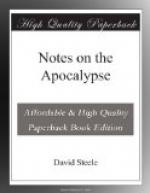Thus “Babylon is fallen, to rise no more at all:” all the visible enemies of the Lord and his Anointed are cut off from the face of the earth: and it remains only that he who originated the rebellious conspiracy be put under necessary restraint.
CHAPTER XX.
1. And I saw an angel come down from heaven, having the key of the bottomless pit and a great chain in his hand.
2. And he laid hold on the dragon, that old serpent, which is the devil, and Satan, and bound him a thousand years.
3. And cast him into the bottomless pit, and shut him up, and set a seal upon him, that he should deceive the nations no more, till the thousand years should be fulfilled: and after that, he must be loosed a little season.
Vs. 1-3.—“And I saw an angel.” This angel is the Lord Christ, (ch. x. 1.) The key is the symbol of authority. (Is. xxii. 22; chs. i. 18; iii. 7.) The dragon had been previously cast down from heaven, (ch. xii. 9;) by the Reformation, and during the “short time” of his liberty, he persecuted the woman and the remnant of her seed, on the earth. Now, however, his career is arrested. “Seizing, binding, casting into the abyss, shutting up, and setting a seal upon that old serpent,” (ch. xii. 9,) are strong figurative expressions, by which his secure confinement is signified. Thus is the devil to be restrained from deceiving the nations for a “thousand years.” That this period is to be taken in a proper, and not in a mystical sense, appears thus. If we multiply one thousand by three hundred and sixty, as some fancifully do, the resulting number of years, three hundred and sixty thousand, would be out of all proportion to the past duration of the world, as well as the well-defined period of 1260 years. Add to this, that when by Daniel and John definite duration is symbolically mentioned, it is by “months, days; time, times and a half a time,” or “the dividing of time,”—never by “years.”




